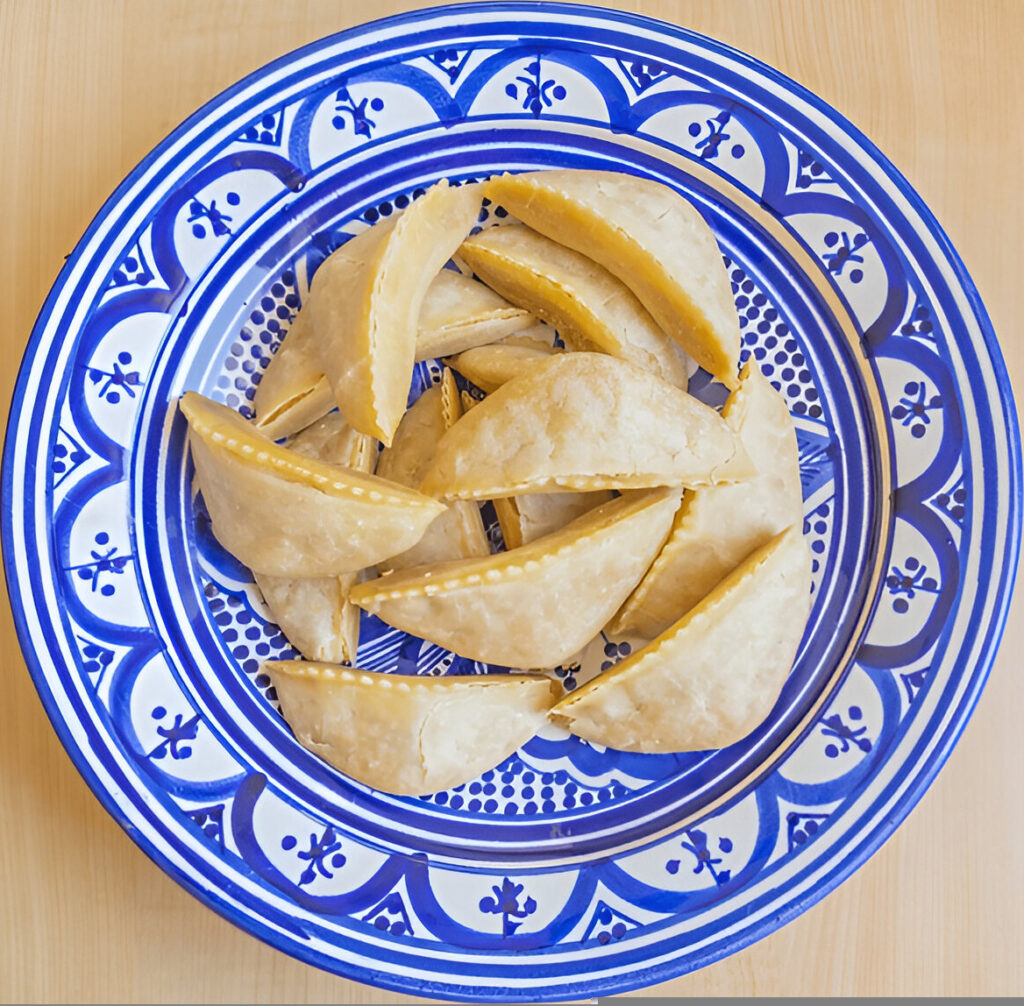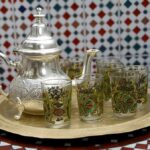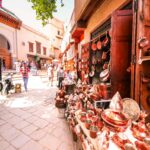
The Irresistible Allure of Gazelle Horns: Morocco’s Most Beloved Pastry
Explore the rich culinary heritage of North Africa through traditional desserts. The Gazelle Horns stand out for their elegance and taste.
These crescent-shaped pastries are a treat for the taste buds. They also show the rich culture of the area. With flaky dough and almond filling, they capture the spirit of Moroccan pastries.
Learning about these sweets reveals their history, craftsmanship, and joy. Whether you love food or are looking for new tastes, the tale of Gazelle Horns will fascinate and motivate you.
The Rich Heritage Behind These Crescent-Shaped Delights
In the heart of Moroccan cuisine, the gazelle horn stands out. It’s a pastry filled with history and tradition. These delicate, crescent-shaped treats are a joy to eat and hold deep cultural value. They are a key part of Moroccan celebrations and traditions.
The gazelle horn, known as “Kaab el Ghzal” in Arabic, showcases Morocco’s rich culinary heritage. Its origins reflect the country’s history and the diverse cultural influences that have shaped its cuisine over the centuries.
Traditional Significance: Gazelle horns are more than a dessert; they symbolize hospitality and community. In Morocco, these pastries are served at special events like weddings and holidays. They bring families and friends together.
Making gazelle horns is a traditional art. It involves crafting a delicate pastry dough and filling it with almond paste. This process requires patience and skill, passed down through generations. Recipes for these pastries are often family treasures.
Gazelle horns hold a special place in Moroccan celebrations. They are a staple at festive occasions and family gatherings. These pastries represent the warmth and generosity of Moroccan hospitality.
In essence, gazelle horns capture the essence of Moroccan cultural heritage. They represent a culinary tradition that is both rich in history and vibrant today. Through their preparation and enjoyment, gazelle horns remain a vital part of Moroccan social and cultural life.
Gazelle Horns: Moroccan Pastries That Captivate the Senses
Trying gazelle horns is a treat for all your senses. It’s a true taste of Moroccan desserts. These pastries delight your eyes, nose, and mouth.
The first thing you notice is their look. Their crescent shape and perfect design show off Moroccan pastry makers’ skill. The golden hue of the pastry makes them almost too pretty to eat.
When you bite into them, the almond pastry opens up. It releases a lovely aroma. The filling, with ground almonds and orange blossom water, is both sweet and fragrant. The texture is smooth and creamy, contrasting with the flaky pastry.
The taste is complex, with sweet almonds and a hint of citrus. As it melts, the flavors deepen, leaving a lasting impression. The aroma of orange blossom water takes you to Morocco’s vibrant markets.
Gazelle horns take you on a journey through Moroccan patisserie. Every part, from looks to flavors, is made to delight. Enjoy them with mint tea or alone, they’re a must-try Moroccan dessert.
In short, gazelle horns are more than a pastry. They’re an experience that brings Morocco’s sights, smells, and tastes to you. They make any moment special.
Essential Ingredients for Authentic Gazelle Horns
To make real gazelle horns, you need the right ingredients. Each one is key to the taste, texture, and look of these Moroccan treats.
Choosing ingredients is more than following a recipe. It’s about knowing how each part adds to the gazelle horns’ unique flavor and feel. From the quality of almonds to the sweeteners and flour, every bit counts.
Selecting and Preparing Quality Almonds
The base of gazelle horns is high-quality almonds. They must be picked and prepared with care. Blanching and grinding them into a smooth paste is essential.
For the best taste and texture, use fresh, plump almonds. Grinding them finely is key to avoiding a rough texture in the pastry.
Traditional Sweeteners and Binding Agents
Honey and orange blossom water are key for their flavor. They add sweetness and aroma to the pastry.
Eggs are also crucial. They help the dough stick together and add to the richness of the horns.
Flour Selection and Quality
The flour you choose is vital. All-purpose flour is common, but some recipes mix it with cake flour for a softer pastry.
Good flour makes the pastry smooth and delicate. Use finely milled flour for the best crust.
The Role of Butter and Oils
Butter and oil add moisture and flavor. The type of butter and oil used can change the taste and feel of the pastry. Unsalted butter is often preferred for its mild taste.
Adding orange blossom water or other flavors to the butter or oil can make the horns more aromatic and true to their Moroccan roots.
Step-by-Step Guide to Making Gazelle Horns at Home
Making gazelle horns is a special tradition in Moroccan cooking. Now, you can learn to make them at home. This pastry needs patience, precision, and practice. But with this guide, you’ll soon be making authentic Moroccan treats.
To start, mix flour, almonds, sugar, and a bit of orange blossom water for the dough. The quality of your ingredients is crucial. It affects the taste and texture of your gazelle horns.
Grinding and Mixing Techniques
Grinding almonds to the right texture is key. Use a food processor or a traditional grinder for a fine texture. Be careful not to overprocess, or you’ll get almond butter instead.
After grinding, mix the almonds with sugar, flour, and cinnamon. Make sure to mix well so all ingredients are evenly distributed.
Achieving the Right Consistency
The dough’s consistency is important. It should be soft but firm enough to hold its shape. If it’s too dry, add a little water. If it’s too wet, add more flour.
As you work with the dough, you’ll learn what consistency is best. It’s a delicate balance, but with practice, you’ll get it right.
Now, let’s go through the steps to make gazelle horns:
1. Mix the ingredients together until a ball forms.
2. Knead the dough until it’s smooth and pliable.
3. Divide the dough into smaller parts for easier handling.
4. Roll out each part into thin sheets for wrapping the filling.
5. Mix ground almonds with sugar and spices for the filling.
6. Place some filling on one half of the dough sheet, then fold the other half to form a crescent shape.
7. Seal the edges well to keep the filling inside during baking.
8. Bake the gazelle horns until they’re golden brown.
By following these steps and tips, you’ll make delicious gazelle horns. Practice makes perfect, so don’t worry if they’re not perfect at first.
For a more authentic experience, use traditional Moroccan ingredients and tools. It will make the process more enjoyable and the result more authentic.
Regional Variations of Gazelle Horns Across Morocco
Gazelle horns are a big deal in Moroccan bakeries. They show the country’s rich food culture. Morocco’s different regions have their own ways of making these horns, each with its own flavors and techniques.
In the north, gazelle horns get a sweet touch from local honey and orange blossom water. The south, however, fills them with dates or other fruits. This makes each region’s horns taste and feel unique. The city of Fez is famous for its gazelle horns, known for their light layers and spices. They use special flour found only there, making them special.
In Marrakech, you can find gazelle horns filled with almond paste and nuts. This variety shows how different tastes are catered to in different places.
The way gazelle horns vary across Morocco shows the local tastes and history. Coastal areas, for example, mix Mediterranean flavors into their horns. This mix of traditions creates a rich flavor experience.
To wrap it up, gazelle horns in Morocco show the country’s love for food and the bakers’ creativity. Each region adds its own twist to this classic pastry. This makes trying gazelle horns a must for anyone who loves Moroccan food.
Common Mistakes to Avoid When Making Gazelle Horns
Making gazelle horns is an art that requires careful attention. One big mistake is overworking the dough. This can make the pastries tough and dense.
To get those flaky layers, keep the butter cold and handle the dough softly. The filling is also key. Too little almond paste makes them taste bland, while too much makes them too rich.
Using a reliable gazelle horn recipe and following pastry tips from experts can help a lot. Make sure the dough rests long enough before shaping. This helps prevent it from shrinking while baking.
When baking, watch the pastries closely. Overbaking dries them out, while underbaking makes them soft. Adjust the baking time as needed to get them just right.
By avoiding these common baking mistakes and sticking to a good gazelle horn recipe, you can make delicious Moroccan pastries at home.
The Role of Gazelle Horns in Moroccan Celebrations
In Morocco, gazelle horns show the country’s warm welcome to guests. They are a key part of many celebrations, like weddings and holidays. People love them for their taste and cultural value.
Gazelle horns are more than just desserts. They represent Morocco’s rich culture. Making these pastries is a family tradition that adds to their meaning. Sharing gazelle horns is a way to show respect and love, bringing people together.
In Moroccan culture, making gazelle horns is an art. The designs and almond paste inside show off Moroccan skill. At celebrations, they are a highlight, sparking interest and admiration.
Gazelle horns are also important at big life events. At weddings, they are among the desserts, bringing joy and good luck. This tradition shows their role in celebrating and welcoming.
To sum up, gazelle horns are key in Moroccan celebrations. They show the country’s culture and traditions. Their presence at events highlights Morocco’s rich food history and love for hospitality.
Storing and Preserving Your Gazelle Horns
Storing gazelle horns is simple and can keep them fresh for a while. To keep their layers and flavors, you need to store them right.
First, let them cool completely on a wire rack. This stops moisture from building up. Then, put them in an airtight container to stay fresh. Keep them away from sunlight and heat to avoid them getting stale or the filling melting.
For up to 2 days, you can store them at room temperature. For longer, refrigerate them. Refrigeration can keep them fresh for a week. Make sure they’re in an airtight container to avoid picking up other smells.
Freezing is great for longer storage. Freeze them on a baking sheet until solid, then bag them up. Thaw at room temperature or reheat in the oven to make them fresh again.
By following these tips, you can enjoy your gazelle horns for longer. You’ll love their taste and texture every time.
Nutritional Profile and Dietary Considerations
Gazelle horns are a pastry filled with almonds, sugar, and pastry dough. They have a specific nutritional value that’s important for those with dietary restrictions. Let’s look at what’s in them.
The almond filling is packed with healthy fats and protein. This makes gazelle horns a filling treat. But, they also have a lot of calories and sugar. This is something to think about if you’re watching your diet.
For those with dietary restrictions, gazelle horns aren’t good because they have gluten. They’re also not safe for people with nut allergies because of the almonds. But, you can make them healthier by using different sweeteners or less sugar.
Knowing what’s in gazelle horns helps you decide if they fit into your diet. Enjoy them in moderation as part of a balanced diet.
Pairing Gazelle Horns with Traditional Moroccan Beverages
To fully immerse in Moroccan culinary culture, it’s essential to pair gazelle horns with the country’s traditional beverages. Moroccan drinks are a key part of the country’s rich food heritage. When paired with gazelle horns, they create a truly authentic experience.
One of the most iconic Moroccan beverages is Atay, or Moroccan tea. This refreshing drink is made with green tea leaves, fresh mint, and sugar. It’s a staple in Moroccan households. The subtle bitterness of the tea complements the sweetness of the gazelle horns, creating a delightful balance of flavors.
For those looking for a non-caffeinated option, fresh juices like orange or pomegranate juice are excellent choices. Their citrusy flavors cut through the richness of the pastries.
Another traditional Moroccan drink that pairs well with gazelle horns is Sharbat. This sweet and fragrant beverage is made from fruits or flowers. Flavors like orange blossom or rose water are particularly popular. They echo the floral notes found in gazelle horns. This harmonious pairing enhances the overall sensory experience, transporting you to the vibrant streets of Morocco.
When enjoying gazelle horns, it’s not just about the taste; it’s about the cultural experience. Pairing these pastries with traditional Moroccan beverages like Atay or Sharbat adds a layer of authenticity to the experience. It makes it a truly memorable culinary adventure.
Where to Find Authentic Gazelle Horns in the United States
Looking for authentic gazelle horns in the United States? You’ll find them in the country’s vibrant Moroccan bakeries. These bakeries are hidden gems in diverse neighborhoods, bringing a taste of Morocco to America.
For authentic gazelle horns, head to cities with big Moroccan communities. New York City and Los Angeles are top spots. Bakeries here use traditional recipes and ingredients, making their pastries almost like those in Morocco.
In New York City, Aladdin’s Cafe in Manhattan has a wide range of Moroccan pastries, including gazelle horns. Los Angeles’ Kasbah Cafe is famous for its authentic Moroccan food and pastries.
Can’t find a bakery near you? Online stores and specialty food shops are great alternatives. Some offer shipping nationwide, so you can enjoy authentic gazelle horns at home.
When searching for authentic gazelle horns, look for bakeries or stores that focus on traditional Moroccan recipes and ingredients. This way, you’ll get delicious and genuine pastries.
Bringing Morocco Home: The Joy of Sharing Gazelle Horns
Sharing desserts is a big part of Moroccan culture. It shows the warmth and hospitality Moroccans are famous for. Gazelle Horns, with their sweet almond filling, are great to share with family and friends.
Making Gazelle Horns at home is more than baking. It’s about joining a cultural exchange that goes beyond borders. Sharing these pastries brings people together, just like Moroccan hospitality welcomes guests with open arms and delicious treats.
When you share your homemade Gazelle Horns, you keep a Moroccan tradition alive. It’s not just about the taste. It’s about the warmth and hospitality they bring. So, invite your loved ones over and enjoy Gazelle Horns together. Let them bring you closer, celebrating cultural exchange and Moroccan hospitality.











Need Handicap Taxi Near Houston? Our Wheelchair & Handicap Transportation provides accessible rides for all. Choose Wheelchair Accessible Taxi Houston, Wheelchair Taxi Houston, or Wheelchair Transportation Houston for safe, comfortable, and professional travel. We ensure punctual, stress-free service for city trips, medical appointments, and airport transportation across Houston.
Choose Taxi Service Houston for quick, safe rides. Known as the best taxi service in Houston, our Cab Houston and Cabs Houston are always ready. From Houston Cab, Houston Taxi, Taxi Cab Houston, to Taxi Houston Near Me, we ensure reliable Taxi in Houston whenever you need it.
Our main priority is to provide comfort, and elegance in our luxury cars and limousines. Our goal is to offer seamless airport transfers in Dubai for both personal and professional trips.